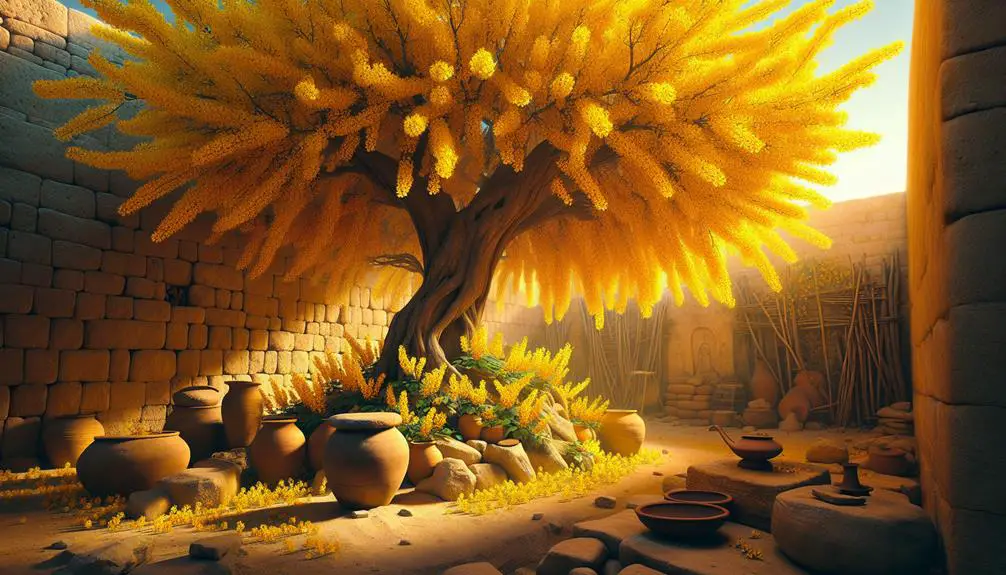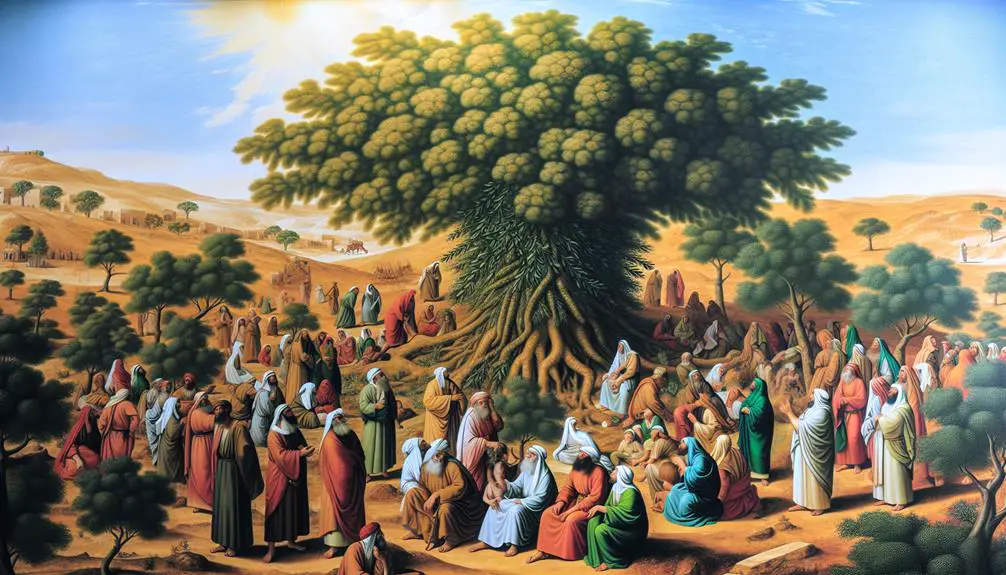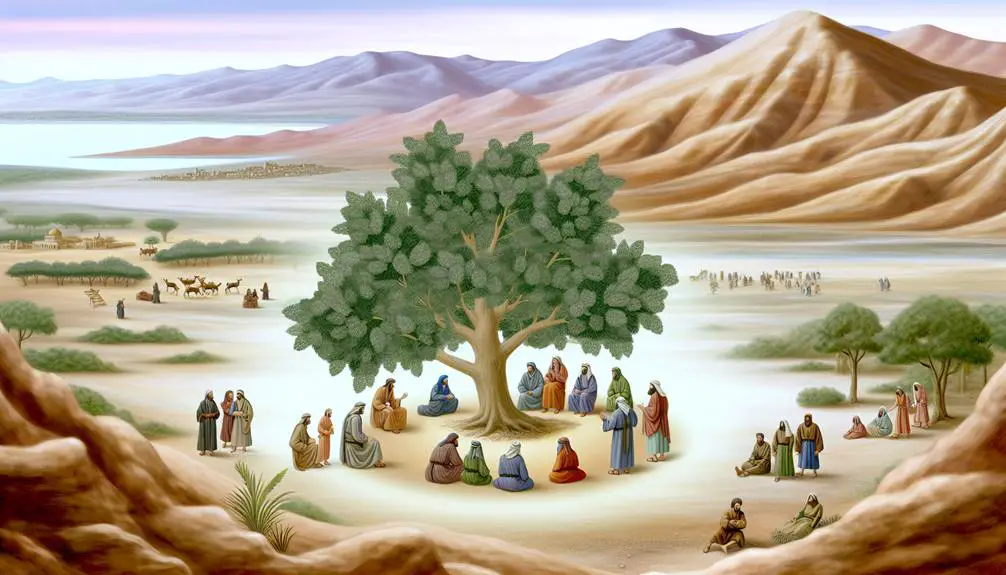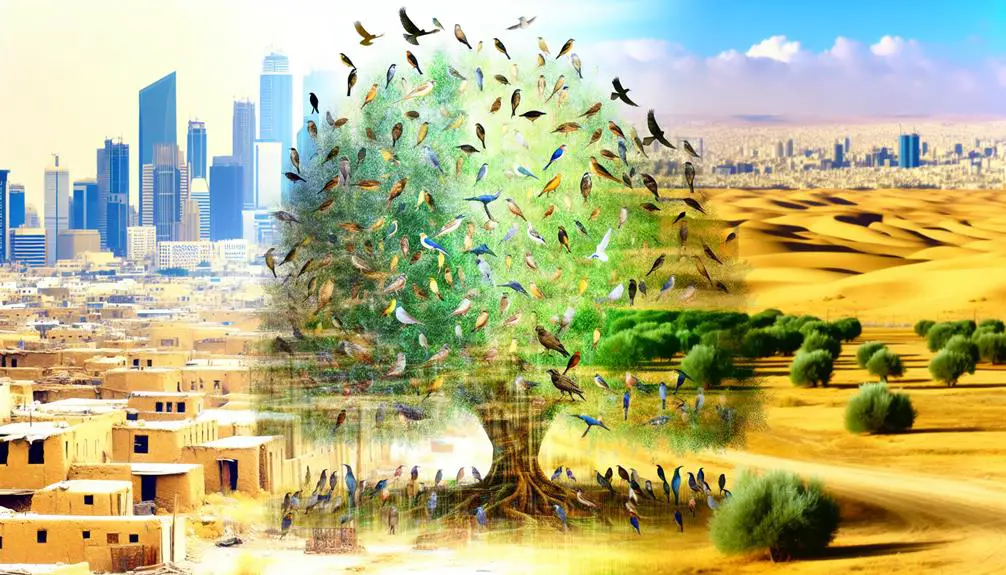Gain insights into the mustard tree's biblical significance, a symbol of faith's growth from the smallest beginnings, and its impact on cultural practices.

Mustard Tree in the Bible
Did you know that the mustard tree, mentioned a few times in the Bible, is used to illustrate one of the most profound principles of faith?
This seemingly modest plant holds a significant place in biblical teachings, especially when it comes to showcasing the power of faith from the tiniest beginnings.
You're probably familiar with the parable of the mustard seed, but have you considered its historical context, or how this analogy has shaped interpretations of faith and growth over centuries?
Exploring this topic further could unveil layers of meaning that have influenced not just religious thought, but also cultural practices around the world.
Key Takeaways
- The Mustard Seed Parable illustrates faith's growth from small beginnings to expansive reach.
- Symbolizes potential and transformation, reflecting on the Kingdom of God's growth and divine patience.
- Emphasizes resilience, adaptability, and the importance of nurturing environments for growth.
- Encourages reflection on personal growth, community support, and environmental stewardship in faith contexts.
Historical Context

In examining the historical context of the mustard tree mentioned in the Bible, it's crucial to understand its symbolic significance in the ancient Near East. Ancient agriculture played a pivotal role in the livelihoods of Near Eastern societies, with regional flora directly influencing dietary, medicinal, and economic practices. The mustard tree, amidst this backdrop, was more than just a plant; it was a symbol of growth and prosperity in a region where agriculture was the cornerstone of survival and success.
As you delve deeper, you'll find that the mustard tree's resilience and rapid growth mirrored the desired characteristics of the societies it thrived in. These societies valued plants that could adapt to the challenging climates and terrains of the Near East. The mustard tree, with its hardy nature, became a metaphor for strength and perseverance in the face of adversity.
Furthermore, the inclusion of the mustard tree in ancient texts highlights its importance in regional flora. It wasn't just a crop; it was a vital part of the ecosystem that supported a wide range of agricultural activities. Its presence in the Bible underscores the intertwined relationship between ancient agriculture, regional flora, and the cultural and spiritual life of the people in the ancient Near East.
Biblical Citations
You'll find that the Mustard Seed Parable, central to understanding the mustard tree's significance in the Bible, offers profound insights into faith and the Kingdom of God.
Exploring tree symbolism reveals layers of meaning about growth and potential, reflecting broader theological themes.
Analyzing interpretations across denominations highlights the diverse ways in which this imagery resonates within Christian thought, underscoring its rich, multifaceted symbolism.
Mustard Seed Parable
Often referenced in biblical teachings, the Parable of the Mustard Seed highlights a profound principle of growth from small beginnings. This narrative uses gardening metaphors to convey the potential of faith's expansion, akin to how a tiny mustard seed grows into a large tree.
It isn't just a story about growth but also delves into the mechanics of seed dispersal, subtly teaching the way faith spreads from person to person, much like seeds are carried by the wind to fertile grounds.
This parable, rich in agricultural imagery, serves as a powerful illustration of how something seemingly insignificant can have a massive impact. It encourages you to understand the exponential potential of faith, starting small but capable of creating widespread influence.
Tree Symbolism Explained
Building on the understanding of growth and influence from the Mustard Seed Parable, let's explore how trees, featuring prominently in biblical narratives, symbolize life, growth, and resilience. Trees are not just physical entities but embody spiritual and moral values across various stories and teachings.
Symbol |
Meaning |
|---|---|
Tree of Life |
Eternal life |
Mustard Tree |
Kingdom of Heaven's growth |
Cedar Tree |
Strength and righteousness |
Fig Tree |
Israel and judgement |
This symbolism extends to color meanings and seed dispersal, highlighting the diversity and complexity of life's journey. Colors like green signify life and renewal, while the process of seed dispersal reflects the spread of faith and teachings. Understanding these symbols adds a rich layer of meaning to the biblical text, illustrating the depth of spiritual lessons encoded in nature.
Interpretations Across Denominations
Throughout the ages, interpretations of biblical trees have varied across Christian denominations, each drawing unique insights from the scriptures. Ecumenical perspectives and denominational practices have shaped the understanding of the mustard tree, leading to diverse interpretations. Here's how:
- Catholicism views it as a symbol of the Kingdom of God's growth from small beginnings.
- Protestantism often emphasizes personal faith's growth, akin to the mustard seed's transformation.
- Orthodoxy integrates it into liturgical teachings, highlighting mystical growth.
- Evangelicalism focuses on evangelistic outreach, paralleling the tree's expansive reach.
These interpretations, while varied, underscore the richness of biblical symbolism, demonstrating how ecumenical perspectives and denominational practices enrich our understanding of scripture.
Symbolism of Growth
The mustard tree's growth from a tiny seed into a large plant mirrors significant spiritual and personal development themes within biblical narratives. This transformation isn't just a metaphor but also a practical reflection on resilience and potential.
By examining the mustard tree's journey, you grasp the environmental impact of such growth, highlighting the adaptability and resilience of nature. This story encourages you to consider how even the smallest actions can lead to significant changes, both in the world around you and within your personal life.
Gardening tips derived from the mustard tree's cultivation process further extend the symbolism of growth. They serve as practical lessons in patience, care, and the importance of nurturing conditions for growth. Just as the mustard tree thrives under the right conditions, you're reminded that personal growth and spiritual development require a conducive environment—whether it's through surrounding yourself with positive influences or seeking enriching experiences.
This analogy teaches you about the significance of foundational elements in achieving growth and the potential within seemingly insignificant beginnings. By embracing these lessons, you're encouraged to cultivate your own growth with intention and patience, mirroring the mustard tree's journey from a small seed to a flourishing plant.
Faith and the Mustard Seed

Reflecting on the mustard tree's growth illuminates another profound biblical principle: faith, even as small as a mustard seed, can move mountains. This comparison isn't just poetic but deeply symbolic, offering a rich ground for seed metaphors and faith discussions.
Here are four ways the mustard seed's symbolism enhances our understanding of faith:
- Size vs. Potential: Despite its minuscule size, the mustard seed grows into a large tree. This juxtaposition serves as a powerful reminder that faith doesn't have to be vast to be effective; it's the potential within that matters.
- Growth Over Time: Just as a mustard seed takes time to grow, faith often develops gradually. Patience is a virtue in spiritual growth.
- Resilience: Mustard trees are known for their hardiness and ability to thrive in difficult conditions. Similarly, a small amount of faith can provide the resilience needed to face life's challenges.
- Transformation: The transformation from a tiny seed to a sprawling tree symbolizes the transformative power of faith. Even the smallest faith can lead to significant changes in one's life and in the world.
Understanding these aspects can deepen one's spiritual perspective and highlight the importance of nurturing even the smallest seed of faith.
Parables Explained
In exploring the parables of the Bible, it's essential to understand that these stories serve as spiritual lessons, cloaked in everyday events and characters, to illuminate deeper truths. At the heart of many of these narratives are growth metaphors, which are masterfully employed to depict spiritual progression, personal development, and the expansion of divine principles within the human heart and community.
Delving into the parable origins, you'll find that they're deeply rooted in the cultural and historical contexts of their times. This grounding in real-life situations made the parables immediately accessible and relatable to their original audiences. By using familiar scenes and characters, these stories bypassed the listeners' defenses, reaching directly into their hearts to instigate reflection, self-examination, and ultimately, transformation.
The mustard seed parable, for instance, uses the growth metaphor to convey the potential of faith. It starts as something seemingly insignificant yet, with nourishment, can grow beyond all expectations. This parable, like others, isn't just a story. It's a mirror reflecting the potential for growth within each person, urging listeners to nurture their spiritual lives with as much care as a gardener tends to their smallest seeds.
Kingdom of God Analogy

Drawing parallels to the growth of the tiniest mustard seed, Jesus illustrates how the Kingdom of God expands from the smallest beginnings into a vast, encompassing presence. This analogy isn't just a lesson in botany; it's a profound insight into the nature of divine patience and the transformative potential inherent in the Kingdom's growth.
Here are four aspects to consider:
- Initial Obscurity: Just as a mustard seed begins as an almost invisible speck, the Kingdom of God often starts in ways that are easily overlooked. This teaches you about the value of small beginnings and the importance of nurturing growth.
- Unexpected Expansion: The mustard seed's growth into a substantial tree symbolizes the Kingdom's capacity to expand beyond initial expectations, highlighting the transformative potential at work.
- Shelter and Nourishment: As the tree grows, it provides shelter and sustenance, illustrating how the Kingdom supports and nurtures those within it.
- Divine Patience: The gradual but assured growth of the mustard tree reflects the patience of God in the unfolding of the Kingdom, emphasizing that significant developments often require time.
Through this analogy, you're invited to appreciate the slow, steady, and surprising ways in which the Kingdom of God unfolds.
Agricultural Insights
You'll find that the mustard seed's growth conditions and the process for harvesting mustard seeds offer profound insights into biblical symbolism. Understanding the specific environmental needs and cultivation methods sheds light on the parable's deeper meanings.
This exploration highlights the intricacies of agricultural practices mentioned in the Bible and their symbolic significance.
Mustard Seed Growth Conditions
To successfully cultivate mustard seeds, one must understand the specific conditions these plants thrive under, including well-drained soil, ample sunlight, and moderate temperatures. Analyzing the growth conditions reveals the adaptability of mustard seeds to various environments, yet they show optimal growth when certain criteria are met:
- Soil Types: Preferably light, well-drained soils with a pH between 6.0 and 7.5.
- Climate Conditions: Temperate climates are ideal, with temperatures ranging from 10°C to 25°C.
- Sunlight: Requires full exposure to sunlight for at least 6 hours daily.
- Watering: Regular, but moderate watering, ensuring the soil remains moist but not waterlogged.
Understanding these agricultural insights ensures you're well-equipped to cultivate mustard seeds effectively, leveraging their resilience and adaptability to various growing conditions.
Harvesting Mustard Seeds
Harvesting mustard seeds requires precise timing and technique to ensure the highest quality and yield. You'll need to monitor the plants closely, as seeds mature at different rates within the same plant. It's crucial to wait until the pods have turned brown but before they burst open – a delicate balance that ensures maximum seed preservation.
Once harvested, the seeds undergo drying, a critical step for long-term storage and to prevent mold growth. Properly dried seeds are essential for both seed preservation and culinary uses, as moisture can drastically affect their flavor and shelf life.
For culinary uses, the seeds' pungency and aroma are best preserved when stored in a cool, dry place. This ensures that when you're ready to use them, they'll contribute their full, intended flavor to your dishes.
Cultural Significance

The mustard tree holds profound cultural significance, deeply rooted in biblical narratives and symbolizing faith's growth from small beginnings. This imagery isn't just a metaphor; it extends into various aspects of life and culture, enriching both spiritual understanding and practical application. You'll find its influence in:
- Mustard recipes: A testament to its versatility and the way small seeds transform into flavors that enrich cuisine.
- Gardening tips: Reflecting the mustard tree's resilience, these insights encourage even novice gardeners to cultivate patience and care.
- Religious teachings: The mustard seed's symbolism in faith and perseverance is a cornerstone in many sermons and spiritual discussions.
- Art and literature: The tree and its seeds often appear as motifs representing growth, faith, and transformation.
Understanding the mustard tree's cultural significance allows you to appreciate its multifaceted role in society. It's not just about the biblical parable; it's about how a small seed can inspire change, enrich diets, influence gardening practices, and weave through the fabric of spiritual and cultural narratives. This depth of influence showcases the mustard tree's enduring legacy beyond its biblical roots.
Interpretations Over Time
You've seen how the mustard tree holds cultural significance within biblical narratives, but understanding its role demands a look at historical contextual analysis and modern symbolic meanings.
Scholars have shifted interpretations, ensuring that both the tree's historical context and its evolving symbolism are thoroughly examined. This evolution in understanding underscores the dynamic nature of biblical symbols and their impact on contemporary faith and scholarship.
Historical Contextual Analysis
Over time, interpretations of the mustard tree mentioned in the Bible have evolved, reflecting changes in theological understanding and cultural contexts. This evolution can be dissected through:
- Geographical Origins: Early interpretations focused on the Middle Eastern origins, considering the climate and soil conducive to its growth.
- Cultivation Techniques: Advances in agricultural knowledge have shed light on how ancient communities might've cultivated mustard trees, influencing their symbolic importance.
- Theological Debates: Scholars have debated the tree's metaphorical significance, with interpretations varying significantly across different eras.
- Cultural Relevance: The mustard tree's significance has been reinterpreted to align with contemporary cultural values and understandings.
This analytical journey shows how historical context enriches our understanding of biblical symbols, making the mustard tree a vibrant subject of study.
Modern Symbolic Meanings
Having explored the historical evolution of the mustard tree's significance, let's now examine how its symbolic meanings have shifted in modern interpretations.
In contemporary art, the mustard tree often represents growth and resilience, echoing its biblical symbolism but infusing it with new life and context. Artists and thinkers alike draw upon its enduring presence to comment on personal and societal endurance.
Meanwhile, discussions around its ecological impact have brought a nuanced understanding to its symbolism. The mustard tree's ability to thrive in harsh conditions is now also seen as a metaphor for environmental adaptation and sustainability.
This dual interpretation, balancing art and ecology, enriches our modern appreciation of the mustard tree, offering a complex symbol of both beauty and resilience in the face of adversity.
Modern Lessons

The parable of the mustard tree, as depicted in the Bible, offers profound modern lessons on growth and potential that resonate deeply with individuals and communities alike. This story isn't just a narrative from the past; it's a blueprint for today, urging you to reflect on how small beginnings can lead to significant outcomes.
Among the myriad lessons it imparts, here are four key takeaways:
- Environmental Stewardship: The growth of the mustard tree from a tiny seed into a robust plant mirrors our responsibility to nurture and protect the environment. It's a call to action for sustainable living and conservation efforts, emphasizing the impact of individual and collective actions on the planet's health.
- Social Justice: The mustard tree's expansive reach symbolizes the necessity of social inclusivity and equity. Just as the tree provides shelter and resources, you're reminded to advocate for policies and practices that ensure fairness and support for marginalized communities.
- Personal Growth: This parable inspires you to embrace growth opportunities, no matter how small they seem. It's about recognizing your potential and the importance of perseverance and resilience in overcoming obstacles.
- Community Development: Lastly, the mustard tree's story highlights the importance of community support and collaboration. It encourages building networks that foster mutual growth and development, reflecting the interdependence of society.
Frequently Asked Questions
How Do Mustard Trees Compare to Other Significant Biblical Plants in Terms of Their Ecological Impact?
You're exploring how mustard trees stack up against other significant plants in their ecological impact, focusing on growth patterns and soil preferences.
Unlike some biblical flora, mustard trees thrive in a range of soils, showing adaptability.
Their rapid growth patterns can overshadow slower-growing plants, impacting local ecosystems.
While they're not the most water-intensive, their aggressive spread can alter soil composition and compete with native species, making their ecological impact quite significant.
Are There Any Specific Rituals or Religious Ceremonies in Contemporary Religions That Still Utilize the Mustard Seed or Tree?
Ironically, you might think of mustard seed recipes before religious rituals, yet many contemporary religions indeed incorporate mustard seeds in their practices. These small seeds play significant roles, not just in agricultural practices but also in symbolizing faith and growth.
From blessings of the fields to ceremonies emphasizing spiritual growth, the mustard seed's humble origins remind followers of potential and transformation, blending ancient traditions with modern ecological awareness and culinary uses.
How Has the Metaphor of the Mustard Seed Influenced Secular Literature and Modern Storytelling Outside of Religious Texts?
In literature and modern storytelling, the metaphor of the mustard seed has profoundly impacted literary motifs and the evolution of storytelling.
You'll find it's subtly woven into narratives, symbolizing growth from the smallest beginnings.
This imagery has transcended its religious origins, inspiring authors to explore themes of faith, resilience, and transformation.
Its use demonstrates an enduring legacy in shaping stories that resonate with universal truths about human potential and perseverance.
What Are the Scientific Challenges or Critiques Concerning the Identification of the Biblical Mustard Tree Within Botany?
You may find it challenging to pin down the biblical mustard tree's genetic lineage within botany. Scientists argue that ancient texts may not accurately reflect today's plant classification, complicating its identification.
Moreover, cultivation practices have evolved, potentially altering the characteristics of what was once considered a mustard tree. These factors contribute to the ongoing debate and difficulty in conclusively identifying the plant referred to in historical texts.
Are There Any Notable Artworks or Historical Monuments That Prominently Feature the Mustard Tree or Seed as a Symbol of Faith?
Certainly!
Venturing into the realm of art and history, you'll find the mustard seed's symbolism as a beacon of faith. Many notable artworks and historical monuments skillfully weave this motif, offering a rich tapestry of artistic interpretations.
These pieces don't just decorate; they deeply analyze and reflect the seed's metaphorical growth from tiny beginnings to expansive influence. It's a testament to the enduring power of symbols to convey profound spiritual truths.
Conclusion
As you've journeyed through the history and symbolism of the mustard seed in the Bible, you've uncovered layers of meaning—growth, faith, and transformation.
This tiny seed mirrors life's potential for monumental change. Yet, the true impact of its parables, deeply rooted in agricultural and cultural landscapes, remains a mystery.
Each interpretation breathes new life into ancient words, challenging you to find your own growth amidst faith's vast field. What'll your mustard seed grow into? The answer lies within.



Sign up